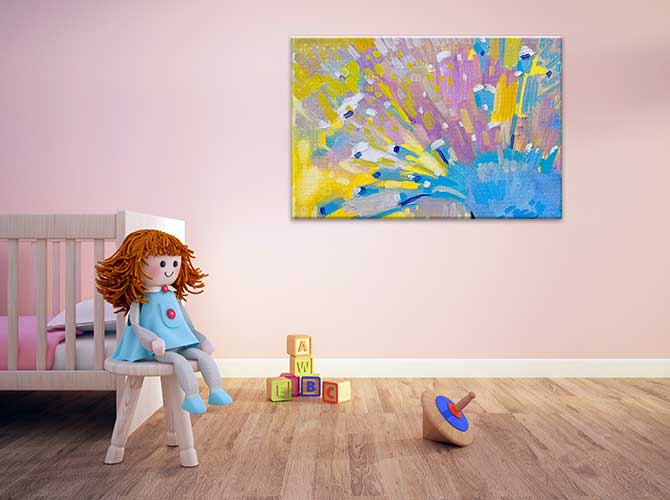
Is There Such A Thing As Abstract Art For Kids?
Share
“But the best thing is to just paint and watch sunrise in your own way.” – Aelita Andre at age 4.
One of the most delightful things about children is the wonder in which they discover the new realities of the world (a flower in the garden, a bird flying by, their first time on the train). The other is the wonder of their imaginations; the different way they perceive the world and the things they simply make up. They have an extraordinary ability to remove the reality that’s right in front of them and create whole new worlds.
They are abstract artists. Everyday. In every way.
Like children’s minds, abstract art removes itself from visual references of the real world. Some abstract art bares absolutely no resemblance to anything recognisable. Some, for example partially abstract art, contains remnants of the real world – something that looks like something real.
And perhaps that is why many people, when they see abstract art say “Any child could paint that!” or “Even I could do that!”

But it’s not as easy as all that, as highlighted by the works of Jackson Pollock, Wassily Kandinsky, Henry Matisse, Pablo Picasso (who founded the revolutionary abstract movement of cubism) and Georges Braque (inventor of collage).
As it turns out, research has shown that people can distinguish abstract expressionist paintings from highly similar paintings by children, chimps, monkeys and elephants. (Source: Seeing the Mind Behind the Art)
Participants in the study preferred professional paintings by abstract expressionist artists and judged them as better than the nonprofessional paintings by children or animals.
“In the aesthetic domain,” the researchers concluded, “people can recognise that a work is good, but still not like it.” (Source: Even a Monkey: Telling Good Abstract Art from Bad)
That all said, there is a case to be made for genius when a child abstract artist does rise to fame.
Born in January 2007, Melbourne painter Aelita Andre began painting at 9 months and, at 22 months, had her first abstract painting displayed in a gallery. Her first solo exhibition was at age four in New York. Here’s an extraordinary video from that time, featuring her work.
Now 7, Aelita Andre continues to paint, exhibit and sell her art. She’s now recognised as the youngest painter in the world. Her art is bright, bold and colourful.
This differs to the softer, pastel style of 5 year old Iris Grace who was diagnosed with autism in 2011 and whose parents discovered, through therapy, her extraordinary talent for art.
But is there such thing as abstract art for kids? I think so.
I think children’s abstract art, whether at a level of genius, sold for thousands and hung in a New York art gallery like Aelita Andre’s works or whether simply created for fun and expression at daycare and hung pride of place on the fridge at home, is appreciated by kids as much as adults.
The colour and dynamism of abstract art speaks to kids. Children’s art does not have to all be literal and educational (B is for bee with a picture of a bee). It can simply be beautiful and create a sense of a fantastical world outside the one in which we live. Abstract art can brighten a child’s room and open a child’s mind.
Abstract art makes for great conversation pieces with children. “What does this picture look like to you?” They’ll no doubt take you to a wondrous place you never would’ve thought of.



So think about stepping outside the world of the alphabet poster and inviting creativity into your child’s room with an abstract art piece. If every child is an artist, so too does every child deserve good art.
“Every child is an artist. The problem is how to remain an artist once we grow up.” – Pablo Picasso


